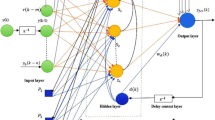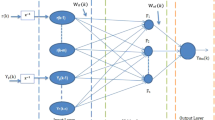Abstract
This work proposes a novel recurrent neural network architecture, called the Dynamically Stabilized Recurrent Neural Network (DSRNN). The developed DSRNN includes learnable skip-connections across a specified number of time-steps, which allows for a state-space representation of the network’s hidden-state trajectory, and a regularization term is introduced in the loss function in the setting of Lyapunov stability theory. The regularizer enables the placement of eigenvalues of the (linearized) transfer function matrix to desired locations in the complex plane, thereby acting as an internal controller for the hidden-state trajectories. In this way, the DSRNN adjusts the weights of temporal skip-connections to achieve recurrent hidden-state stability, which mitigates the problems of vanishing and exploding gradients. The efficacy of the DSRNN is demonstrated on a forecasting task of a recorded double-pendulum experimental model. The results show that the DSRNN outperforms both the Long Short-Term Memory (LSTM) and vanilla recurrent neural networks, and the relative mean-squared error of the LSTM is reduced by up to \(\sim \)99.64%. The DSRNN also showed comparable results to the LSTM on a classification task of two Lorenz oscillator systems.





Similar content being viewed by others
References
Schmidhuber J (2015) Deep learning in neural networks: an overview. Neural Netw 61:85–117
Hochreiter S, Schmidhuber J (1997) Long short-term memory. Neural Comput 9(8):1735–1780
Gers FA, Schmidhuber J, Cummins F (1999) Learning to forget: continual prediction with lstm
Greff K, Srivastava RK, Koutník J, Steunebrink BR, Schmidhuber J (2016) Lstm: a search space odyssey. IEEE Trans Neural Netw Learn Syst 28(10):2222–2232
Lippi M, Montemurro MA, Degli Esposti M, Cristadoro G (2019) Natural language statistical features of lstm-generated texts. IEEE Trans Neural Netw Learn Syst 30(11):3326–3337
Yu X, Wu L, Xu C, Hu Y, Ma C (2019) A novel neural network for solving nonsmooth nonconvex optimization problems. IEEE Trans Neural Netw Learn Syst
Qin S, Xue X (2014) A two-layer recurrent neural network for nonsmooth convex optimization problems. IEEE Trans Neural Netw Learn Syst 26(6):1149–1160
Che H, Wang J (2018) A two-timescale duplex neurodynamic approach to biconvex optimization. IEEE Trans Neural Netw Learn Syst 30(8):2503–2514
Chen K, Yao L, Zhang D, Wang X, Chang X, Nie F (2019) A semisupervised recurrent convolutional attention model for human activity recognition. IEEE Trans Neural Netw Learn Syst
Lipton ZC, Kale D, Wetzel R (2016) Directly modeling missing data in sequences with rnns: improved classification of clinical time series. In: Machine learning for healthcare conference, pp 253–270
Miller J, Hardt M (2018) Stable recurrent models. arXiv preprint, arXiv:1805.10369
Bao G, Peng Y, Zhou X, Gong S (2020) Region stability and stabilization of recurrent neural network with parameter disturbances. Neural Process Lett 52(3):2175–2188
Chandran R, Balasubramaniam P (2013) Delay dependent exponential stability for fuzzy recurrent neural networks with interval time-varying delay. Neural Process Lett 37(2):147–161
Ba JL, Kiros JR, Hinton GE (2016) Layer normalization. arXiv preprint, arXiv:1607.06450
Bengio Y, Boulanger-Lewandowski N, Pascanu R (2013) Advances in optimizing recurrent networks. In: 2013 IEEE international conference on acoustics, speech and signal processing, pp 8624–8628, IEEE
Jaeger H, Lukoševičius M, Popovici D, Siewert U (2007) Optimization and applications of echo state networks with leaky-integrator neurons. Neural Netw 20(3):335–352
Zhang Y, Chen G, Yu D, Yaco K, Khudanpur S, Glass J (2016) Highway long short-term memory rnns for distant speech recognition. In: 2016 IEEE International Conference on Acoustics, Speech and Signal Processing (ICASSP), pp 5755–5759, IEEE
Kim J, El-Khamy M, Lee J (2017) Residual lstm: design of a deep recurrent architecture for distant speech recognition. arXiv preprint, arXiv:1701.03360
Haviv D, Rivkind A, Barak O (2019) Understanding and controlling memory in recurrent neural networks. In: International conference on machine learning, pp 2663–2671, PMLR
Kalman RE, Bertram JE (1960) Control system analysis and design via the “second method" of lyapunov: I—continuous-time systems. J Basic Eng 82(2):371–393
Hauser M, Gunn S, Saab S Jr, Ray A (2019) State-space representations of deep neural networks. Neural Comput 31(3):538–554
Tay Y, Luu AT, Hui SC (2018) Recurrently controlled recurrent networks. In: Bengio S, Wallach H, Larochelle H, Grauman K, Cesa-Bianchi N, Garnett R (eds) Advances in neural information processing systems 31, pp 4736–4748, Curran Associates, Inc
Asseman A, Kornuta T, Ozcan A (2018) Learning beyond simulated physics
de Jesús Serrano-Pérez J, Fernández-Anaya G, Carrillo-Moreno S, Yu W (2021) New results for prediction of chaotic systems using deep recurrent neural networks. Neural Process Lett, pp 1–18
Bof N, Carli R, Schenato L (2018) Lyapunov theory for discrete time systems. arXiv preprint, arXiv:1809.05289
Werbos PJ (1990) Backpropagation through time: what it does and how to do it. Proc IEEE 78(10):1550–1560
Pascanu R, Mikolov T, Bengio Y (2013) On the difficulty of training recurrent neural networks. In: International conference on machine learning, pp 1310–1318
Ouyang X, Luo Y, Liu J, Liu Y, Bi J, Qiu S (2018) Period analysis of chaotic systems under finite precisions. In: 2018 26th International conference on systems engineering (ICSEng), pp 1–5, IEEE
Glorot X, Bengio Y (2010) Understanding the difficulty of training deep feedforward neural networks. In: Proceedings of the thirteenth international conference on artificial intelligence and statistics, pp 249–256
Kingma DP, Ba J (2014) Adam: a method for stochastic optimization, arXiv preprint, arXiv:1412.6980
Abadi M, Barham P, Chen J, Chen Z, Davis A, Dean J, Devin M, Ghemawat S, Irving G, Isard M et al (2016) Tensorflow: a system for large-scale machine learning. OSDI 16:265–283
Author information
Authors and Affiliations
Corresponding author
Additional information
Publisher's Note
Springer Nature remains neutral with regard to jurisdictional claims in published maps and institutional affiliations.
Rights and permissions
About this article
Cite this article
Saab, S., Fu, Y., Ray, A. et al. A Dynamically Stabilized Recurrent Neural Network. Neural Process Lett 54, 1195–1209 (2022). https://doi.org/10.1007/s11063-021-10676-7
Accepted:
Published:
Issue Date:
DOI: https://doi.org/10.1007/s11063-021-10676-7




